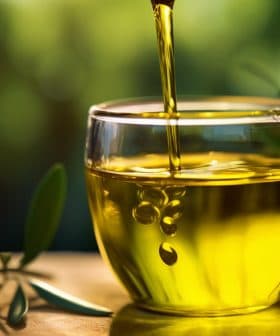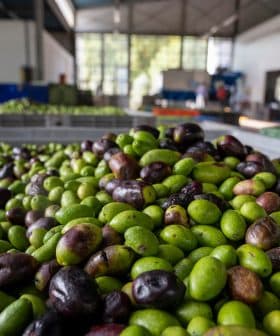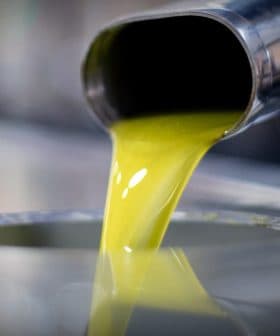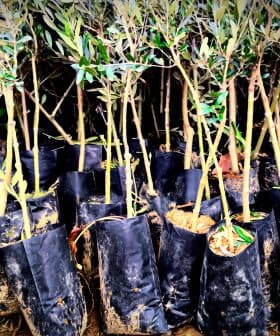The Cost of Anthracnose
An effort is being made to combat the widespread olive disease anthracnose, which caused significant damage to the olive oil sector in Italy’s Puglia region last season. The main treatment, copper-based fungicide, is not always effective in suppressing the disease, which has been reported in various countries. Calls are being made for stronger responses and international collaboration among scientists, industry specialists, and olive growers to manage anthracnose more effectively, as well as for further research into more successful disease control methods.
Calls are being made for a more concerted effort to combat the devastating olive disease anthracnose, which last season caused about €53 million ($71m) damage to the olive oil sector in Italy’s Puglia region alone.
The fungal disease has also been reported in Portugal, Spain, Greece, Tunisia, Serbia, Montenegro, Australia, New Zealand, South Africa, Brazil, Argentina and Uruguay, and the main treatment — copper-based fungicide — is not always effective in suppressing it.
Italian Member of the European Parliament Sergio Silvestris, who is from Apulia (Puglia), and Australian Vera Sergeeva, who specialises in olive pests and diseases, are among those seeking a stronger response.
Silvestris recently asked in a written question if the European Parliament would allocate funding to “monitor the spread of the epidemic and for preventive measures.”
“The disease is caused by a fungus, and symptoms tend to appear mainly in fruits when they have nearly ripened, posing a serious problem as regards production. Diseased olives drop prematurely from the trees, resulting in yield loss; when pressed they produce a very turbid and highly acidic reddish oil of poor quality,” he said.
In its reply, the EC said that because the organisms causing olive anthracnose — Colletotrichum gloeosporioides and C. acutatum — are widely distributed in the EU, they are not eligible for regulation or a financial contribution under the EU plant health regime. And given other pressing priorities and limited funds, the EC did not envisage allocating specific research funding for monitoring or preventing the disease, it said.
Sergeeva told Olive Oil Times that there was a need for an international group of highly-qualified scientists, industry specialists and olive growers to combine efforts on anthracnose management. Coordination of field trials would help prevent research duplication in different countries and make the research more productive. “We have to share our knowledge and work together,” she said.
What is anthracnose and how widespread is it?
It’s best known for infecting mangoes, but grape, avocado, lemon, orange, almond, strawberry, apple and papaya are among other crops anthracnose affects. Australia’s pistachio farmers, for instance, expected a bumper last year but instead, after summer downpours saw the pest thrive, they had a harvest from hell, with their nuts blackened by the fungal disease.
Sergeeva says that anthracnose is a widespread and severe disease in most olive-growing countries, causing significant yield losses, poor fruit and olive oil quality. “In Spain, the overall loss in net income for the olive industry caused by Colletotrichum fungi is estimated to be over $93.4 million a year,” she said.
“In Australia, the disease affects up to 80 percent of olives in susceptible cultivars such as Barnea, Manzanillo, Kalamata and UC13A6. In Portugal, it is very common and has caused losses of up to 100%, particularly in the widely cultivated variety Galega, which is very susceptible.”
“In autumn 2006, significant losses were reported from cultivars such as Arbequina and Picual, previously regarded as moderately resistant, and widely cultivated throughout the Iberian peninsula,” Sergeeva said.
Sergeeva explained what’s known, and what’s yet to be understood, about anthracnose.
What would be most useful for producers to know about this disease?

Dr. Sergeeva: That the infection can persist from season to season and that its incidence depends on factors including olive variety, environment and the virulence of the pathogen. Warm, rainy, misty and humid conditions or heavy dews have been observed to be associated with severe anthracnose epidemics. Over-watering should be avoided in the grove where anthracnose is present. The objective is to prevent disease outbreaks and the development of severe early-season epidemics.
An olive variety of Italian, Spanish, Greek or Israeli origin will not necessarily behave in the same manner in respect to quality or quantity if grown somewhere else in the world. In Australia, for instance, we can grow olives outside a typical Mediterranean climate — but with risks.
Is fungicide treatment expensive or complicated?
Copper-based fungicides are now the main method of disease control but they are not effective in suppressing anthracnose disease in olives under high disease pressure.
Disease management is also made more difficult by the presence of different species of Colletotrichum (C. acutatum and C. gloeosporioides) and recently a third species in Italy (C. clavatum). Affected groves may have one or both species of the pathogen present.
Complete coverage of large, tall trees is hard to achieve; spraying is not very efficient and might not be justified or feasible. While control might occur in some situations, anthracnose can return annually and warrant a continued treatment. And in rainy years, the application of chemical treatments can be difficult.
Many olive growers complain that strobilurin fungicides are very expensive. Not every olive grower can afford expensive chemicals. And using Amistar is complicated for olive growers because this fungicide is phytotoxic to certain apple varieties. Therefore, as a precaution, Amistar should not be applied when there is a risk of spray drift onto neighboring apple crops.
Resistance to the strobilurin fungicides in anthracnose populations has been reported on some crops.
Is pruning effective in anthracnose disease management?
Yes, it can be. Diseased twigs, peduncles, pedicels and suckers should be pruned during the dormant season and removed from the grove and destroyed. Pruning is also important to maximize sunlight infiltration and air movement within the tree. This helps with the natural control of anthracnose and reduces the pressure on the fungicide. The idea is to try to prevent the life cycle from starting or to interrupt it once started.
The pre-flowering (buds) and flowering (flowers) stages are more critical for infection; however infection also occurs during fruit set. In this case, spraying would be effective in reducing anthracnose. Use two sprays, one before flowering and one in early fruit set.
What are the priorities for research on anthracnose?
The current practice of applying fungicides to control anthracnose disease has not been successful. This appears to be due to inefficient timing of application and the wrong choices of fungicide. While organic olive farmers have virtually no choice in the selection of fungicides, apart from a few types of copper, non-organic farmers have followed an irrational approach to fungicides. Therefore, one of the key objectives of disease management is to develop a rational approach to disease control. Different timings of the application of the pesticides and nutrients need to be tested to measure consequent disease incidence.
Foliar application of nutrients between fruit set and harvest is a relatively new control strategy and needs more research. Other issues needing further study include the impact of soil amendments with nutrients or compost on the development of fungal disease and the interaction between irrigation and the disease.










